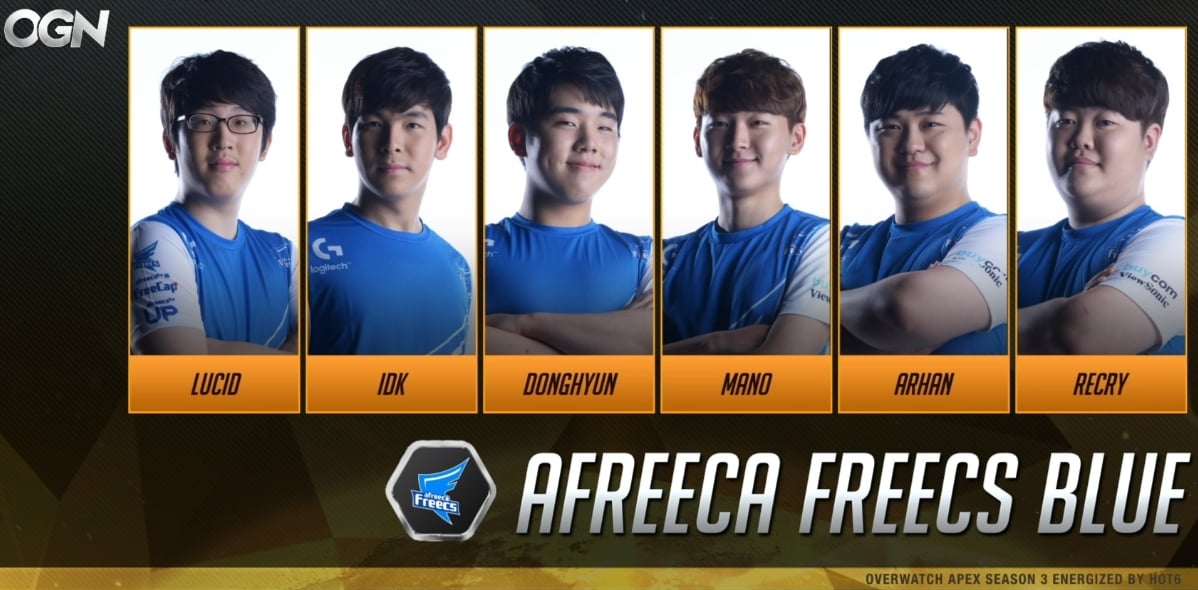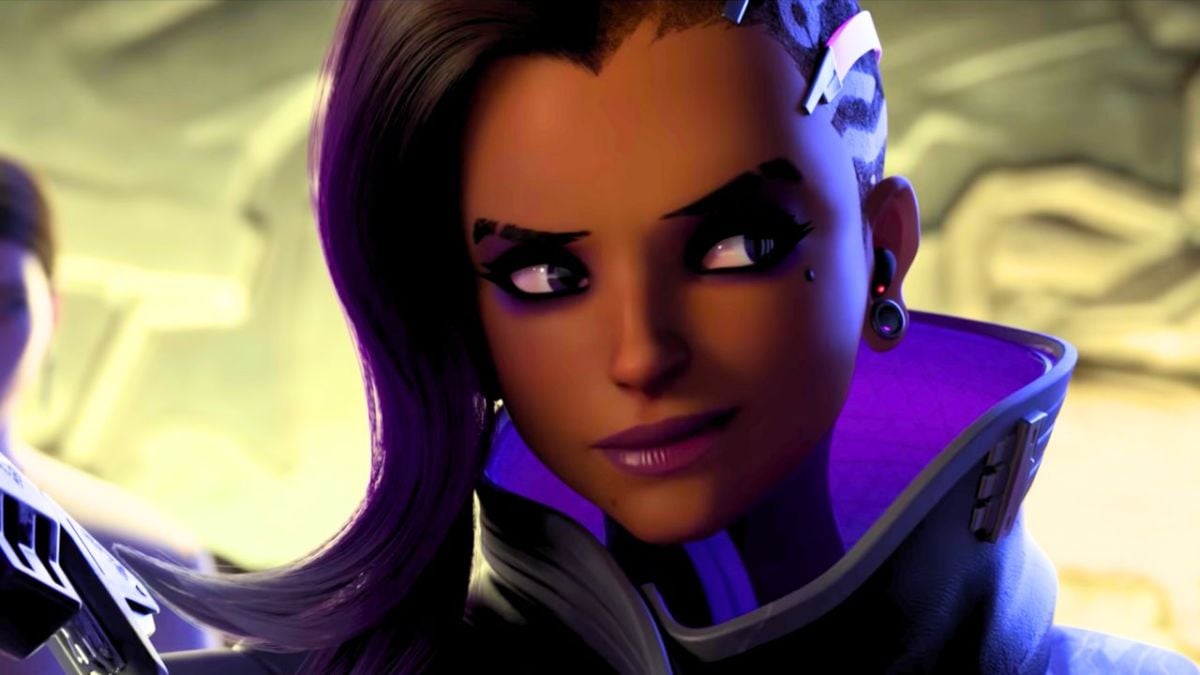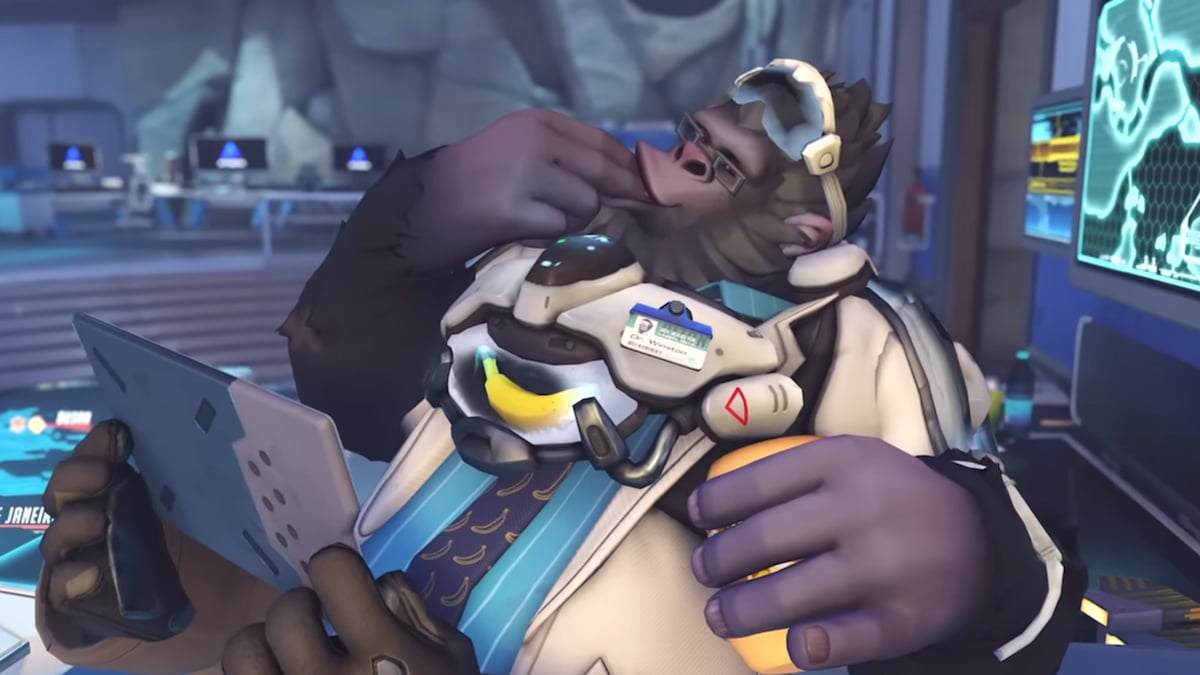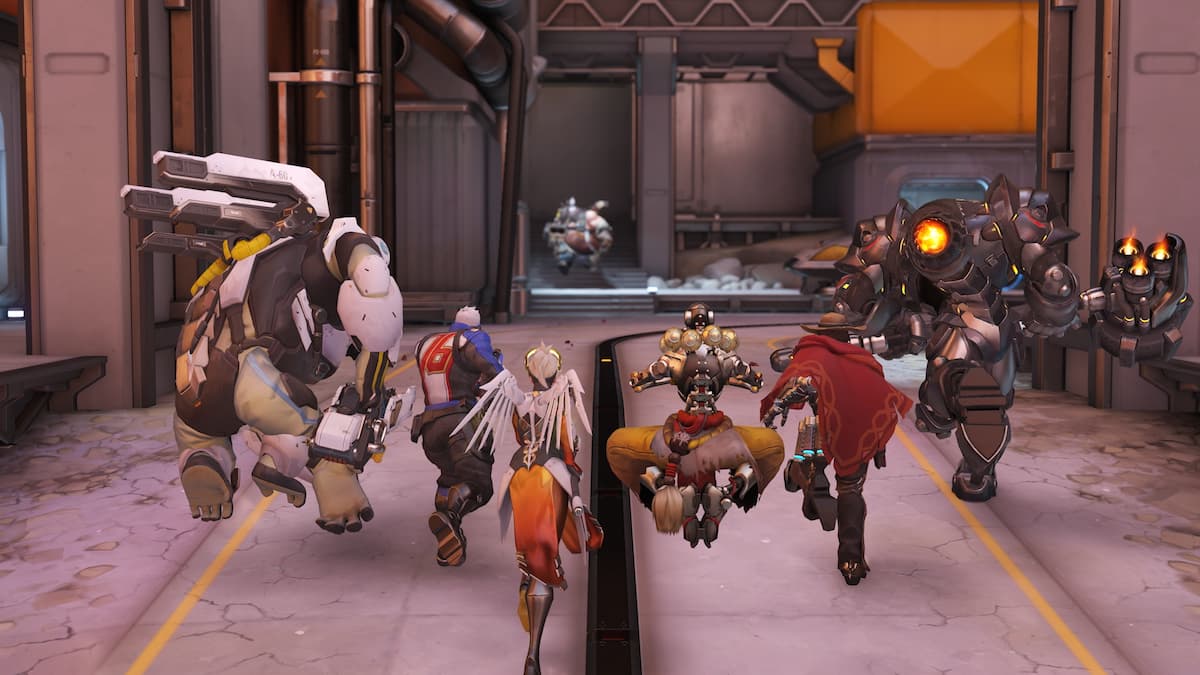Afreeca’s early entrance into Overwatch was not surprising. With a history in League of Legends and Starcraft 2, their initial success was not a surprise either. They decided on their priorities and transferred Jeong “Recry” Taek-hyun from the secondary team, Afreeca Red, to the main roster, Afreeca Blue.
The joining of DPS players Recy and Jeong “Arhan” Weon-hyeop proved to be one of many shrewd roster changes Afreeca would make over their history. These out-of-game choices, combined with a bit of luck, has allowed Afreeca Blue to continually defy the expectations of the community.
While they never built a dynasty of championships like Envyus or Lunatic-Hai, Afreeca Blue certainly established rule over their own castle.
Construction begins
Our expectations for Afreeca Blue coming into the first season of Apex were low. But the combination of a well established strategy and a bit of luck helped them make a deep tournament run, all the way to the grand finals.
Just days before the tournament started they fell in the APAC Premier quarterfinals to Rogue, and failed to qualify for the Nexus Cup following a 2-0 loss to Kongdoo Panthera.
And Afreeca’s initial results reflected those performances. They were manhandled 3-0 by Rogue in their opening Apex match. Recry’s Hanzo performance on Eichenwalde was impressive, and if you had just watched that map you may have thought Recry was the star DPS player. But in fact, over all three maps, it was Arhan who maintained the steadier, and higher, level of impact on Genji.
Although that dynamic hasn’t survived, that series did set the tone of Afreeca’s play for the next couple seasons. Arhan would receive the majority of the team’s resources, such as Nano Boosts and Zarya shields, as the team funnelled their tools onto Arhan and hedged their bets he could win them the fight. This strategy jokingly would come to be known as the bloody path, where Arhan would slice open a pathway for his team to follow with his Dragonblade.
Despite the risks of such a one-dimensional strategy Afreeca prevailed over the other two foes in their group, Rhinos Gaming Titan and Flash Lux. Each of these series were dominant, making it clear chance was not involved. But heading into the playoffs Afreeca hit a lucky streak.
In a bizarre playoff seed drawing, personal grudges led teams to pick their rivals instead of the easiest opponent, leading the strongest four teams into the bottom side of the bracket. Afreeca benefited massively from this as they were able to glide their way to the finals where EnVyUs quickly dismantled them 4-0.
The weaker side of the bracket was required for Afreeca to reach the finals as they had already begun to fail to adapt to the emerging metagame. Following D.Va’s massive Defense Matrix buff she quickly took over professional play. Arhan was forced to flex off of his beloved Genji in favor of the tank, and the lack of playmaking for the roster was noticed against EnVy.
Although many analysts did not believe it was deserved, Afreeca ultimately went home with the silver medal. Nobody, however, was saying that Afreeca was not a playoff quality team as they were able to prove themselves over Reunited and BK Stars. But following the off-season roster shuffle and the addition of new team,s the second season of Apex would not be as strong for Afreeca.
Cracks begin to show
The success they found in the inaugural season of Apex seemed to bite Afreeca by granting them undeserved confidence. Despite changes to their roster, they stuck to the same Arhan-centric style. This made them a predictable, and therefore weaker, team, whose fate ended up out of their control.
The field was much tougher heading into season two. With a season of professional play under everyone’s belts, coaches and organizations better understood how to build Overwatch rosters. Several teams, such as Lunatic-Hai and LW Blue, had shored up weaknesses with roster moves. Meanwhile, fresh talents like Meta Athena looked like major threats.
Afreeca knew they had to keep up, and they made two series of roster moves. The first, in preparation for IEM Gyeonggi, saw the roster dropping flex-tank player Jo “Jin” Hyo-hin and flex-support player Ahn “Yesman” Jun-hyuk in favor of Kim “Mano” Dong-gyu and Ahn “Amy” Min-yeong respectively.
After that iteration of Afreeca bombed out of IEM, the organization decided more change was needed. The version of Afreeca that would compete in Apex season two saw Amy and Park “Dayfly” Jeong-hwan both dropped as supports. Kim “Amon” Kyung-jae was brought in as flex-support and Mano moved to playing Lucio with Bae “Donghyun” Dong-hyun replacing him as the flex-tank.
In hindsight, we now know that the pieces were there to form a strong roster. The line-up that Afreeca entered into season two with struggled, however. Only able to prey on a Cloud9 that was figuring out their identity with a new roster, Afreeca’s fate was left in the hands of Kongdoo Uncia.
The final series of group C, between Kongdoo Uncia and Cloud9, would determine the group’s second seed. If C9 won they would continue, otherwise Afreeca would progress. That critical series went a full five maps, and on Eichenwalde ultimately C9 fell. Afreeca once again had a stroke of luck, and factors outside of their control allowed them to progress further in the tournament than they perhaps should have.
Once into the GSL-style quarterfinals Afreeca quickly lost both series, even failing to defeat LW Blue whose star DPS, Yeon-oh “Flow3r” Hwang, was injured. Falling out in the 7-8th spot was a disappointing end to the weakest event from Afreeca to date.
Watching their play over again, it isn’t much of a surprise. They continued to heavily invest in the bloody path strategy despite Arhan’s failures to deliver. This made it easy for teams to prepare strategies against Afreeca, and was a glaring weakness in their play.
It was obvious that Arhan was no longer performing where Recry was. Arhan receives his team’s Nano Boost and uses his own Dragonblade only to find nothing. Analysts and casters alike questioned why Afreeca seemingly refused to adapt. But Afreeca doggedly stuck to their guns and didn’t put Recry at the center of attention.
Heading into season three, Afreeca’s focus finally did change, but it wasn’t onto Recry. It was onto Mano.
Peak of the castle
For Afreeca the story of Apex season three really is the story of Mano. Mano’s transition to main-tank will go down in Overwatch history as one of the quickest and most successful role changes. And in the end, his rapid development as a main-tank player ended up being the reason he left the squad.
Much like season two, the break leading into season three was another massive roster shuffle for the Apex teams. The largest moves were within Kongdoo, as they put together the ideal roster on Panthera. In the Kongdoo mania, Afreeca took the chance to pick up Jun-set “Lucid” Yoo, who was a proven flex support player. They also scouted out and added Park “IDK” Ho-jin as their new Lucio player.
With a full-time Lucio on the roster, something had to happen with Mano, who had occupied that role the previous season. Afreeca’s answer was to drop their long-time main tank Kim “Adam” Yoon-hik and slot Mano into that role. This would prove to be the best roster decision Afreeca ever made.
Mano had never been a main tank. Before joining Afreeca, he was a flex-tank player for Rhinos Gaming Wings, primarily responsible for Zarya and D.Va duties. And, outside of a single series at IEM, Mano had been a full-time Lucio player for Afreeca.
When he was placed on Lucio, the team said it was because of his awareness and gamesense. It seems easy to speculate they anticipated him to be a leader from the backline with those qualities to his play. But those same qualities make a great Winston player, and Mano quickly proved to be one of the best.
The impact of Mano’s Winston was immediately obvious in Afreeca’s first series against X6-Gaming. His dives were well-timed, and the entire team rotated around him to form an incredibly effective dive threat. And, as the season progressed, he continued to perfect his newfound craft—to the point where he began to draw comparisons to Jin-hyuk “Miro” Gong, who had long held the title of the best Winston in the world.
It was high praise, but well deserved. Mano’s Winston play became the bedrock that Afreeca built their strategy around in season three. Combined with Arhan’s emergence as a passable Tracer, which finally allowed Recry greater protection, the results spoke for themselves. They destroyed their group, winning every series without dropping a single map.
Their quarterfinal group was no different. Afreeca faced down Meta Athena and X6, dispatching them both 2-0. They were not strong enough to stand in the way of fate, however, and in the semifinals they fell to the eventual champions, Lunatic-Hai. To close out their season they took their vengeance on EnVyUs for the season one finals to take home the bronze medal.
While Afreeca placed one spot lower than their season one performance, the third time around was by far the most impressive performance we had ever seen from the team. They earned their third place finish, and at the time were considered a top three or top four team in the world.
But the castle was about to come crumbling down.
Deeper cracks appear
Afreeca Blue and their fans only got to enjoy a single season with the incredible frontline duo of Mano and Donghyun. After their departure from the roster Afreeca scrambled to find replacements, all of whom paled in comparison. With their former primary strength gone, Afreeca were incapable of making playoffs.
Just three weeks after taking third place, the team announced on Facebook that Donghyun would be stepping onto the bench. And two weeks later, Afreeca announced that Mano was leaving for LW Blue, likely enticed by the offer to play on an Overwatch League team.
Stepping into their shoes were Son “Brek” Yong-ha, formerly of MVP Infinity, into main tank and Shin “Kalios” Woo-yeol, previously from RunAway and wNv.KR, into flex tank. In addition, as Afreeca Blue’s sister team, Afreeca Red, had disbanded, they brought Lee “InYounng” In-yeong into the roster as a support player. Another Afreeca Red alum, but more recently of the Rox Orcas, Jung “TyDolla” Seung-min was added as a flex player.
The addition of four new players proved to be a difficult puzzle for Afreeca Blue to decipher, one that they never seemed to figure out. InYounng and IDK split the Lucio duties roughly 50-50 and TyDolla, originally brought on as a flex player, played in their elimination match as main-tank.
These bizarre role swaps seem to have been a desperate attempt from Afreeca to find a winning combination. Formerly a strong point for Afreeca with Mano, the Winston play in particular suffered for Afreeca. The first two series of the season featured Brek, and despite winning some maps and even a series he looked disjointed.
Brek’s dives were not as well coordinated with the rest of Afreeca, leading him to often be the first casualty of the fight. Without the disruption that Winston normally causes, it became easy for Afreeca to get run over in teamfights.
But Afreeca’s most bizarre decision was to abandon any progress they had made with Brek, and sub in TyDolla as Winston in the final match to determine their tournament lives. The series against GC Busan was do-or-die for Afreeca, and they opted for the latter.
TyDolla’s Winston was even worse—an unsurprising fact, considering he is known for Genji and Sombra play. Neither of which have remotely similar responsibilities to a tank. He was just as de-synced from Afreeca as Brek. But, unlike Brek, he didn’t even seem comfortable on Winston. A few times he accidentally collided with terrain while jumping forward, which halted his progress and left him vulnerable.
Their luck had run out, as roster issues and weak tank play contributed to Afreeca’s worst season ever. And for the first time ever they failed to make the top eight of an event. Fortunately for Afreeca they were not the worst team in their group so they are not facing relegation. But the question still must be asked: Can they save their crumbling castle?
Can the door be held?
Formerly one of the best in the world, Afreeca Blue are now not even a top 10 team in Korea. If the roster stays together there is a chance, with time, they can smooth out their synergy issues. But that isn’t a guarantee.
But the upcoming Overwatch League presents a potential death blow. Individual talent may be picked off the roster to play in the Overwatch League, particularly Recry. And in that case, they will not be practicing with Afreeca—if they ever return.
If Recry were to leave Afreeca, they would lose a key cog in their machine, one who has been a consistent performer for three seasons, and a good role-player for the roster. Without him, even more doubt would be cast over Afreeca’s future.
Afreeca’s castle is still intact, but appears on the verge of collapse. It will take a bit of their old magic to pull it back together.






Published: Sep 25, 2017 01:00 pm